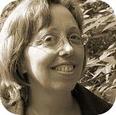My husband notices trains, shoes, and bakeries. A friend of mine notices sound patterns and graphic design. I notice light and color, emotions, and the shapes of people’s nostril holes.
We can’t notice everything. We don’t have the time or the attention span. So we sort – based on our interests and fascinations, our habits, our past, and a whole lot more. Our fancy brains feed the resulting tidbits to our consciousness.
Noticing what we notice gives us unbeatable, richly endless, top-quality material for our creations. And the collection of things we notice gives us an even richer goldmine of intertwined, layered, very unique, meaningful fodder. By being aware of what we notice, we bring into consciousness the juicy underlayer that informs what we create.
—————
For three months in the midst of my university education I travelled around the Pacific Northwestern United States with 12 other students, studying the area’s environmental issues and ecology. A few years later, two of us from that trip led a similar trip to California, covering some of the same ground in Northern California that we’d covered on our first trip as students.
During our planning trip, we quickly realized that we hadn’t been on the same first trip at all. I mean, not at all. This became frustratingly obvious as we drove around northern California.
“Turn here,” he’d say. “Remember how this meets up with Highway 89, just after that curve up there. There’s a great rock formation on the left about a quarter of a mile past that bend.”
I’d actually stop the car in the middle of the road and stare at him. “Are you kidding me?” I’d say. “You remember that?” He’d shrug. “Sure. Don’t you?”
Or we’d walk through a campground and I’d say, “These are the two campsites we had on the last trip. Mary sat on that big rock and cried and no one knew why. And George and Lisa made dinner for everyone here at this picnic table, giving each other the silent treatment the whole time.” He’d stare at me with a look of incredulity, throw his hands in the air, and say, “Of course I don’t remember that. Who cares!”
Though we’d been on the exact same trip for three months, spending pretty much 24 hours a day together in the same group in the same places doing the same things, we had zero common memories.
What you notice creates your world.
—————
So, what do you notice?
You can ask people close to you for their insights about what you notice. Sometimes things are so obvious to us we don’t realize that others don’t see them.
What do the people you’re with notice? Being with someone else can open up whole new worlds as we take a trip into their world.
We’re all tour guides of the worlds we inhabit. This can’t help but show in our creations. Even if our creation is dinner. Or what route to take on the hike. Or how to crop the photo. Or what to include in the summary report.
When we create from and share our vision, we introduce others to new vistas. When we’re curious about what others have created, it’s like we’re visiting a foreign country. It’s a student exchange. It’s important. Make the most of it.
“By asserting our vision, we strive not to impose our view on others, as an act of aggression, but to share it, as an act of generosity.”
– Peter Turchi
Grace founded The Curious Writer to help writers and other creative explorers find their own path, with the assumption that creativity and writing involve the whole person. Curious writers use the art of writing in order to grow, and grow in order to further master the art of writing. The Curious Writer focuses on creativity and empowerment, for writers and anyone interested in finding their own way.
Grace has published articles online and in print magazines. She's the author the healthy boundaries guide, Stay Afloat When Theiy're Rocking Your Boat, and a series of devious daily Creativity Prompts.
As a Writer's Shepherd, Grace helps authors who want to finish their writing project but don't know how, helping authors find their own trail through the wilderness of possibilities. As an editor, she also evaluates and tweaks in the substantive and copyediting phases of writing.

Post new comment
Please Register or Login to post new comment.